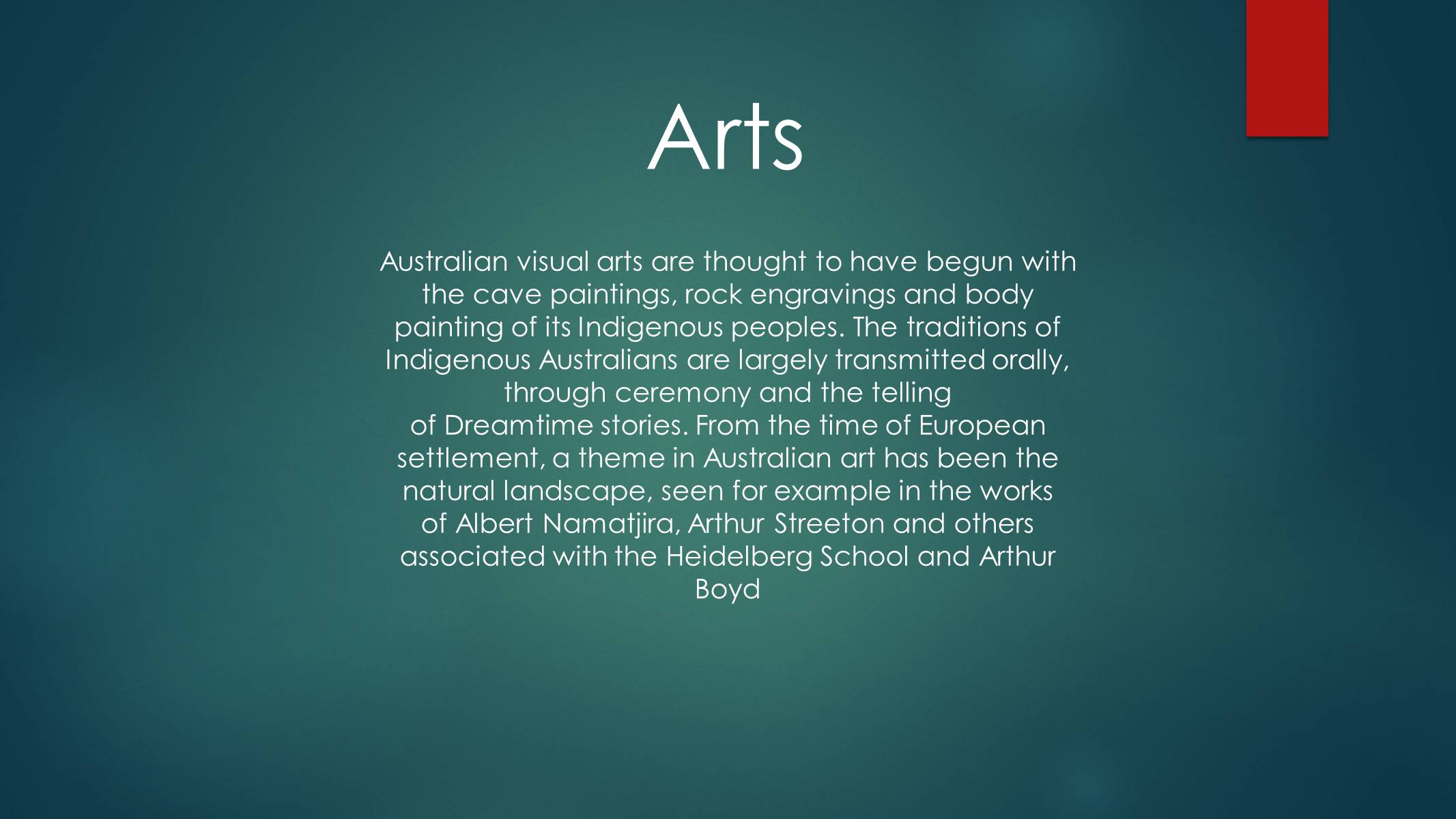- Головна
- Готові шкільні презентації
- Презентація на тему «Australia» (варіант 3)
Презентація на тему «Australia» (варіант 3)
235
Слайд #1
Australia

Слайд #2
On 1 January 1901, the six colonies federated, forming the Commonwealth of Australia. Since Federation, Australia has maintained a stable liberal democratic political system that functions as afederal parliamentary democracy and constitutional monarchy. The federation comprises six states and several territories. The population of 23.1 million is highly urbanised and heavily concentrated in the eastern states. The capital of Australia, Canberra.

Слайд #3
One of the largest cities in Sydney

Слайд #4
Officially the Commonwealth of Australia, is a country comprising the mainland of the Australian continent, the island of Tasmania, and numerous smaller islands. It is the world's sixth-largest country by total area. Neighbouring countries include Indonesia, East Timor and Papua New Guinea to the north; the Solomon Islands, Vanuatu and New Caledonia to the north-east; and New Zealand to the south-east.

Слайд #5
Australia is a developed country and one of the wealthiest in the world, with the world's 12th-largest economy. In 2012 Australia had the world's fifth-highest per capita income, Australia's military expenditure is the world's 13th-largest. With the second-highest human development index globally, Australia ranks highly in many international comparisons of national performance, such as quality of life, health, education, economic freedom, and the protection of civil liberties and political rights. Australia is a member of the United Nations, G20, Commonwealth of Nations, ANZUS, Organisation for Economic Co-operation and Development (OECD), World Trade Organization, Asia-Pacific Economic Cooperation, and the Pacific Islands Forum.

Слайд #6
Although most of Australia is semi-arid or desert, it includes a diverse range of habitats from alpine heaths to tropical rainforests, and is recognised as a megadiverse country. The fungi typify that diversity; the total number that occur in Australia, including those not yet discovered, has been estimated at around 250,000 species, of which roughly 5% have been described. Because of the continent's great age, extremely variable weather patterns, and long-term geographic isolation, much of Australia's biota is unique and diverse. Approximately 85% of flowering plants, 84% of mammals, more than 45% of birds, and 89% of in-shore, temperate-zone fish are endemic. Australia has the greatest number of reptiles of any country, with 755 species.

Слайд #7
Although most of Australia is semi-arid or desert, it includes a diverse range of habitats from alpine heaths to tropical rainforests, and is recognised as a megadiverse country. The fungi typify that diversity; the total number that occur in Australia, including those not yet discovered, has been estimated at around 250,000 species, of which roughly 5% have been described. Because of the continent's great age, extremely variable weather patterns, and long-term geographic isolation, much of Australia's biota is unique and diverse. Approximately 85% of flowering plants, 84% of mammals, more than 45% of birds, and 89% of in-shore, temperate-zone fish are endemic. Australia has the greatest number of reptiles of any country, with 755 species.

Слайд #8
Although most of Australia is semi-arid or desert, it includes a diverse range of habitats from alpine heaths to tropical rainforests, and is recognised as a megadiverse country. The fungi typify that diversity; the total number that occur in Australia, including those not yet discovered, has been estimated at around 250,000 species, of which roughly 5% have been described. Because of the continent's great age, extremely variable weather patterns, and long-term geographic isolation, much of Australia's biota is unique and diverse. Approximately 85% of flowering plants, 84% of mammals, more than 45% of birds, and 89% of in-shore, temperate-zone fish are endemic. Australia has the greatest number of reptiles of any country, with 755 species.

Слайд #9
Education
School attendance, or registration for home schooling, is compulsory throughout Australia. Education is the responsibility of the individual states and territories so the rules vary between states, but in general children are required to attend school from the age of about 5 up until about 16. In some states (e.g., WA, NT & NSW), children aged 16–17 are required to either attend school or participate in vocational training, such as an apprenticeship.
Australia has an adult literacy rate that was estimated to be 99% in 2003. However, a 2011–12 report for the Australian Bureau of Statistics reported that Tasmania has a literacy and numeracy rate of only 50%. In the Programme for International Student Assessment, Australia regularly scores among the top five of thirty major developed countries (member countries of the Organisation for Economic Co-operation and Development). Catholic education accounts for the largest non-government sector.
School attendance, or registration for home schooling, is compulsory throughout Australia. Education is the responsibility of the individual states and territories so the rules vary between states, but in general children are required to attend school from the age of about 5 up until about 16. In some states (e.g., WA, NT & NSW), children aged 16–17 are required to either attend school or participate in vocational training, such as an apprenticeship.
Australia has an adult literacy rate that was estimated to be 99% in 2003. However, a 2011–12 report for the Australian Bureau of Statistics reported that Tasmania has a literacy and numeracy rate of only 50%. In the Programme for International Student Assessment, Australia regularly scores among the top five of thirty major developed countries (member countries of the Organisation for Economic Co-operation and Development). Catholic education accounts for the largest non-government sector.

Слайд #10
Education
School attendance, or registration for home schooling, is compulsory throughout Australia. Education is the responsibility of the individual states and territories so the rules vary between states, but in general children are required to attend school from the age of about 5 up until about 16. In some states (e.g., WA, NT & NSW), children aged 16–17 are required to either attend school or participate in vocational training, such as an apprenticeship.
Australia has an adult literacy rate that was estimated to be 99% in 2003. However, a 2011–12 report for the Australian Bureau of Statistics reported that Tasmania has a literacy and numeracy rate of only 50%. In the Programme for International Student Assessment, Australia regularly scores among the top five of thirty major developed countries (member countries of the Organisation for Economic Co-operation and Development). Catholic education accounts for the largest non-government sector.
School attendance, or registration for home schooling, is compulsory throughout Australia. Education is the responsibility of the individual states and territories so the rules vary between states, but in general children are required to attend school from the age of about 5 up until about 16. In some states (e.g., WA, NT & NSW), children aged 16–17 are required to either attend school or participate in vocational training, such as an apprenticeship.
Australia has an adult literacy rate that was estimated to be 99% in 2003. However, a 2011–12 report for the Australian Bureau of Statistics reported that Tasmania has a literacy and numeracy rate of only 50%. In the Programme for International Student Assessment, Australia regularly scores among the top five of thirty major developed countries (member countries of the Organisation for Economic Co-operation and Development). Catholic education accounts for the largest non-government sector.

Слайд #11
Culture
Since 1788, the basis of Australian culture has been strongly influenced by Anglo-Celtic Western culture. Distinctive cultural features have also arisen from Australia's natural environment and Indigenous cultures. Since the mid-20th century, American popular culture has strongly influenced Australia, particularly through television and cinema. Other cultural influences come from neighbouring Asian countries, and through large-scale immigration from non-English-speaking nations
Since 1788, the basis of Australian culture has been strongly influenced by Anglo-Celtic Western culture. Distinctive cultural features have also arisen from Australia's natural environment and Indigenous cultures. Since the mid-20th century, American popular culture has strongly influenced Australia, particularly through television and cinema. Other cultural influences come from neighbouring Asian countries, and through large-scale immigration from non-English-speaking nations

Слайд #12
Culture
Since 1788, the basis of Australian culture has been strongly influenced by Anglo-Celtic Western culture. Distinctive cultural features have also arisen from Australia's natural environment and Indigenous cultures. Since the mid-20th century, American popular culture has strongly influenced Australia, particularly through television and cinema. Other cultural influences come from neighbouring Asian countries, and through large-scale immigration from non-English-speaking nations
Since 1788, the basis of Australian culture has been strongly influenced by Anglo-Celtic Western culture. Distinctive cultural features have also arisen from Australia's natural environment and Indigenous cultures. Since the mid-20th century, American popular culture has strongly influenced Australia, particularly through television and cinema. Other cultural influences come from neighbouring Asian countries, and through large-scale immigration from non-English-speaking nations

Слайд #13
Arts
Australian visual arts are thought to have begun with the cave paintings, rock engravings and body painting of its Indigenous peoples. The traditions of Indigenous Australians are largely transmitted orally, through ceremony and the telling of Dreamtime stories. From the time of European settlement, a theme in Australian art has been the natural landscape, seen for example in the works of Albert Namatjira, Arthur Streeton and others associated with the Heidelberg School and Arthur Boyd
Australian visual arts are thought to have begun with the cave paintings, rock engravings and body painting of its Indigenous peoples. The traditions of Indigenous Australians are largely transmitted orally, through ceremony and the telling of Dreamtime stories. From the time of European settlement, a theme in Australian art has been the natural landscape, seen for example in the works of Albert Namatjira, Arthur Streeton and others associated with the Heidelberg School and Arthur Boyd

Слайд #14
Arts
Australian visual arts are thought to have begun with the cave paintings, rock engravings and body painting of its Indigenous peoples. The traditions of Indigenous Australians are largely transmitted orally, through ceremony and the telling of Dreamtime stories. From the time of European settlement, a theme in Australian art has been the natural landscape, seen for example in the works of Albert Namatjira, Arthur Streeton and others associated with the Heidelberg School and Arthur Boyd
Australian visual arts are thought to have begun with the cave paintings, rock engravings and body painting of its Indigenous peoples. The traditions of Indigenous Australians are largely transmitted orally, through ceremony and the telling of Dreamtime stories. From the time of European settlement, a theme in Australian art has been the natural landscape, seen for example in the works of Albert Namatjira, Arthur Streeton and others associated with the Heidelberg School and Arthur Boyd

Слайд #15
Media
The Australian cinema industry began with the 1906 release of The Story of the Kelly Gang, which is regarded as being the world's first feature-length film; but both Australian feature film production and the distribution of British-made features declined dramatically after World War I as American studios and distributors monopolised the industry, and by the 1930s around 95% of the feature films screened in Australia were produced in Hollywood. By the late 1950s feature film production in Australia had effectively ceased and there were no all-Australian feature films made in the decade between 1959 and 1969
The Australian cinema industry began with the 1906 release of The Story of the Kelly Gang, which is regarded as being the world's first feature-length film; but both Australian feature film production and the distribution of British-made features declined dramatically after World War I as American studios and distributors monopolised the industry, and by the 1930s around 95% of the feature films screened in Australia were produced in Hollywood. By the late 1950s feature film production in Australia had effectively ceased and there were no all-Australian feature films made in the decade between 1959 and 1969

Слайд #16
Frame from the film "Australia"

Слайд #17
Thank you for your attention.
